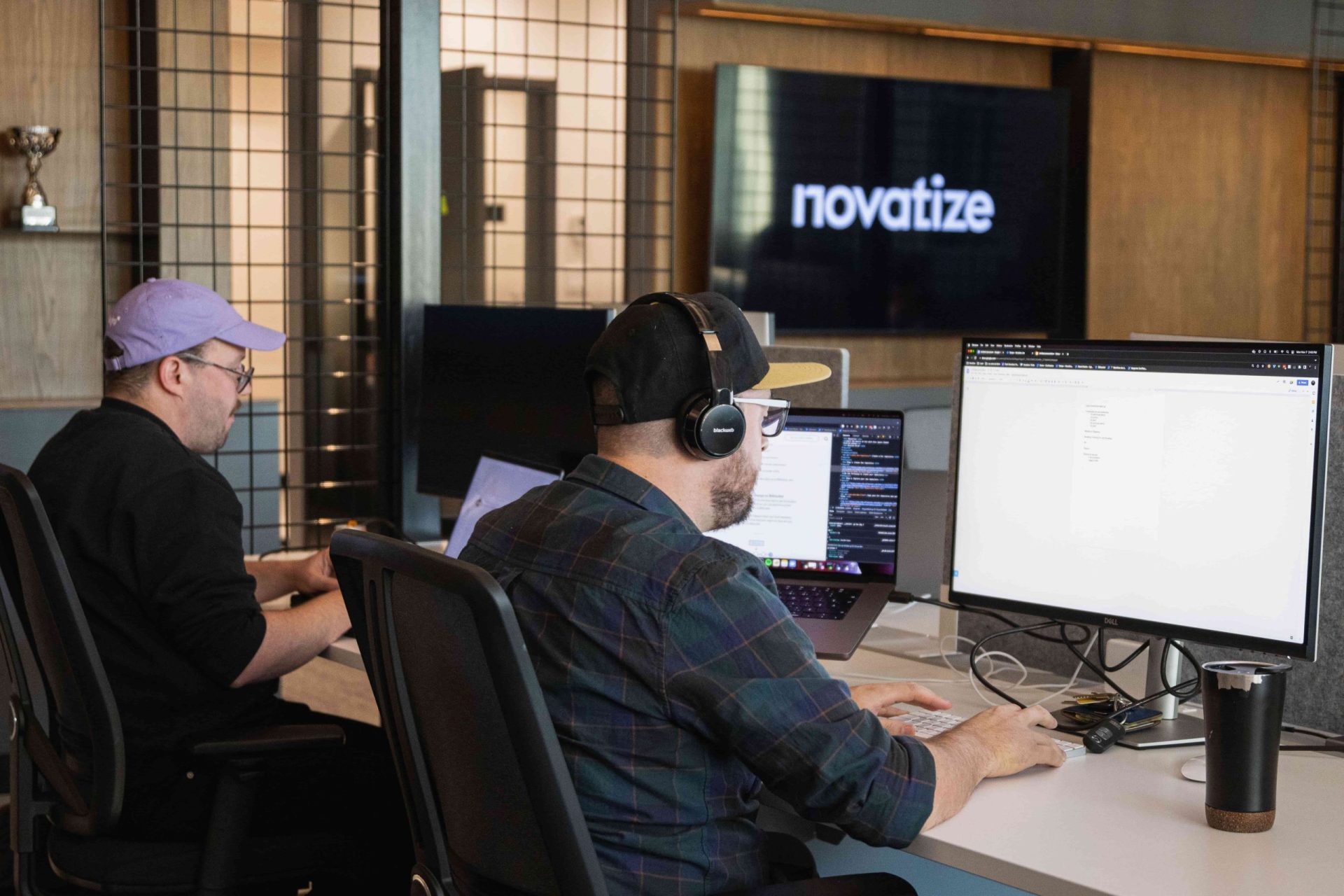The world of eCommerce is evolving rapidly. eCommerce merchants must keep up with the latest trends and technologies to remain competitive. Some concepts that have emerged recently and transformed the industry are composable commerce, headless, and MACH architecture. This article will provide you with definitions and applications to understand the principles of modern eCommerce.
Maximize Your Business Potential with MACH
Download the free whitepaper now
What is Composable Commerce?
Composable commerce is a new way of thinking about creating and managing eCommerce sites. Rather than relying on a single platform, composable commerce sites are built from several independent microservices that can be assembled and reassembled to create a unique eCommerce experience. These microservices may include product catalog, payment, order management, and customer management services.
The beauty of composable commerce lies in its flexibility. Companies can easily add or remove features based on their business needs. Additionally, microservices are designed to be reusable, allowing companies to quickly create new eCommerce sites or update existing ones.
Merchants can use independent microservices to create a personalized eCommerce experience for their customers. Here are some examples of composable commerce applications for merchants:
A merchant can use microservices to
- Create a personalized eCommerce experience for each customer based on their preferences and purchase history.
- Easily add new features to their eCommerce site based on their customers’ needs.
- Quickly develop eCommerce sites for new product lines or markets.
Suppose you want to sell products online from a Shopify store. To offer a more personalized eCommerce experience, you can use Shopify Components, a Shopify solution that allows you to add additional features to your online store.
By using a composable commerce architecture, you can integrate Shopify Components into your Shopify online store and take advantage of these additional features. You can add components such as product recommendation, product search, and promotion modules to offer a more personalized and comprehensive eCommerce experience.
By using Shopify Components, you can create an online store that uses multiple components to offer a more personalized and flexible eCommerce experience.
Find How MACH Can Help Your Business
Download the free whitepaper now
What is Headless eCommerce?
Headless eCommerce is a method of developing eCommerce sites. Rather than using an all-in-one eCommerce platform, headless eCommerce separates business logic from the user interface. This means that the user interface can be developed independently of the underlying business logic, providing greater flexibility and design freedom.
Headless eCommerce also enables businesses to create more personalized and engaging eCommerce experiences. Developers can use modern technologies such as APIs and microservices to create smooth and frictionless shopping experiences.
Merchants can use this approach to offer a personalized and smooth shopping experience to their customers. Here are some examples of headless eCommerce applications for merchants:
A merchant can use headless eCommerce to
- Offer a consistent shopping experience across multiple channels, including websites, mobile apps, and connected devices.
- A merchant can use headless eCommerce to create personalized shopping experiences based on each customer’s preferences and purchase history.
- A merchant can use headless eCommerce to improve the speed and performance of their eCommerce site.
Assuming you have a furniture and decor sales business and need an online store with advanced features to enhance user experience. Using Magento (Adobe eCommerce) for example as an e-commerce platform, you can create a robust online store with multiple features to improve the user experience.
However, to offer an even more personalized user experience, you can use the headless approach to separate the presentation of the content from the template normally used for rendering the experience. This allows you to customize the presentation of your content for each device, which is crucial for providing an optimal user experience.
With the headless approach, you can use Magento as the backend to manage all the features of your online store, including product management, orders, and payments. Then you can use a front-end presentation platform such as React or Vue.js to customize the presentation of your content. Several boilerplate-type platforms also offer you a very advanced starting point at the front-end level that saves you from starting from scratch; for example: Vue Storefront or Next.JS Commerce both contain industry-standard basket and catalog components.
For example, you can use Vue.js to create a custom user interface for your online store, which can be optimized for use on mobile. You can also use Vue.js to create a different user interface for your online store on desktop, which can be more complex and offer more features.
By using Magento as the backend and Vue.js as the front-end presentation platform, you can offer an optimal and personalized user experience on different devices and screens.

What is MACH Architecture?
The MACH architecture is an approach that involves using cutting-edge technologies such as microservices, APIs, and containers to build highly scalable and flexible e-commerce sites. MACH is an acronym for Microservices, API-First, Cloud-Native, and Headless.
What are Microservices?
This refers to a software development approach in which an application is broken down into several independent services, each responsible for a specific task. Microservices are easier to develop, test, and deploy than more traditional monolithic applications.
E-commerce sites that follow the MACH architecture are designed to be modular and extensible. Companies can easily add new features or integrate third-party services to their e-commerce site using microservices and APIs.
What is API-First?
This stands for Application Programming Interface. APIs allow different applications to communicate with each other and share data in a standardized way.
What is Cloud-Native?
This refers to a software development and deployment approach designed to work optimally in a cloud computing environment.
What is Headless?
This means that the front-end of the application, or the user interface, is separated from the back-end, which handles the application’s functionality. This allows developers to design more flexible and customizable user interfaces.
To understand the difference between monolithic or MACH architecture, check out this video.
How to implement MACH in your eCommerce?
Merchants can use this approach to offer personalized and flexible shopping experiences to their customers. Here are some examples of how merchants can apply the MACH architecture:
A merchant can use the MACH architecture to:
- Create scalable e-commerce sites that can handle high traffic volumes.
- Easily add new features to their e-commerce site based on their customers’ needs.
- Quickly develop e-commerce sites for new markets
Assuming a sports equipment online sales company wants to implement a MACH architecture for their eCommerce site. The first step would be to break down their eCommerce platform into distinct microservices such as order management, product management, content management, payment processing, etc.
Then, they could use modern MACH-compatible technologies such as Contentful for content management, React with Hydrogen for the front-end, and Shopify Components for product and order management. By using these technologies, the company could provide seamless and personalized shopping experiences to its customers while offering increased flexibility and scalability.
Here is an example of a MACH architecture

For example, the company could use Shopify Components to manage product details such as images, descriptions, variants, and prices, while Contentful would allow for quickly retrieving dynamic content information based on the market to display on the homepage. Hydrogen would enable personalizing the user experience using user data to present relevant products on the page.
By using the MACH architecture with modern MACH-compatible technologies such as Shopify Components, this sports equipment company could offer a fast, seamless, and personalized user experience while remaining flexible and scalable to meet future needs.
In conclusion, composable commerce and the MACH architecture offer an innovative and promising approach for e-commerce companies seeking to provide a more personalized, flexible, and faster customer experience. The modularity, flexibility, and speed offered by composable commerce enable companies to better respond to changing customer and market requirements, while the MACH architecture provides a modern infrastructure to support these approaches.
By combining the benefits of composable commerce and the MACH architecture, companies can develop consistent, responsive, and scalable customer experiences while reducing costs and accelerating time-to-market for their products. This allows them to remain competitive in an increasingly complex and competitive market.
Harness the Power of MACH
Download the free whitepaper now
If you need help tracking and improving your KPIs, don’t hesitate to contact us at Novatize for expert advice and support.
Inspired by what you’ve read?
Our team of experts can help you take your eCommerce to the next level!




